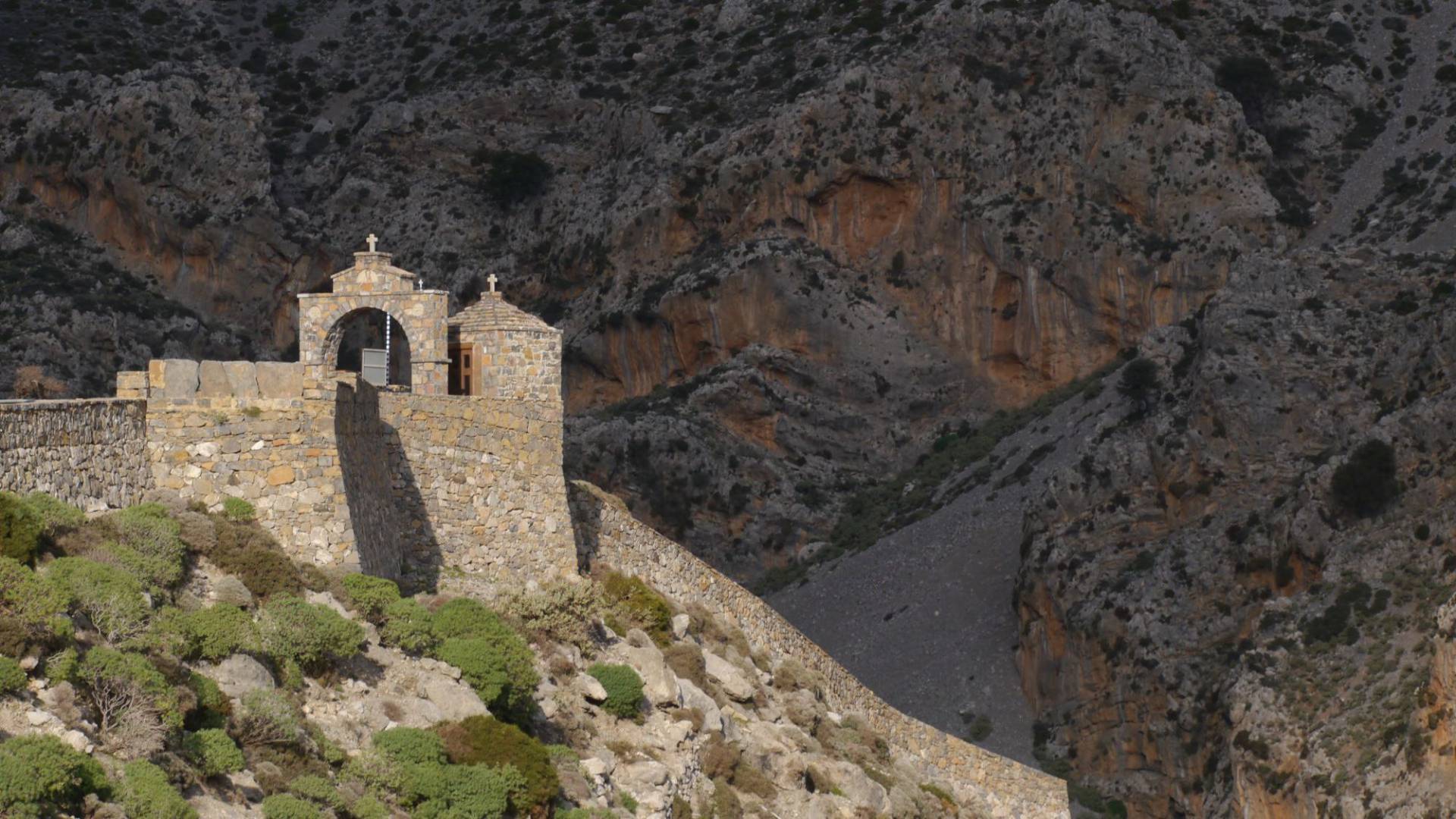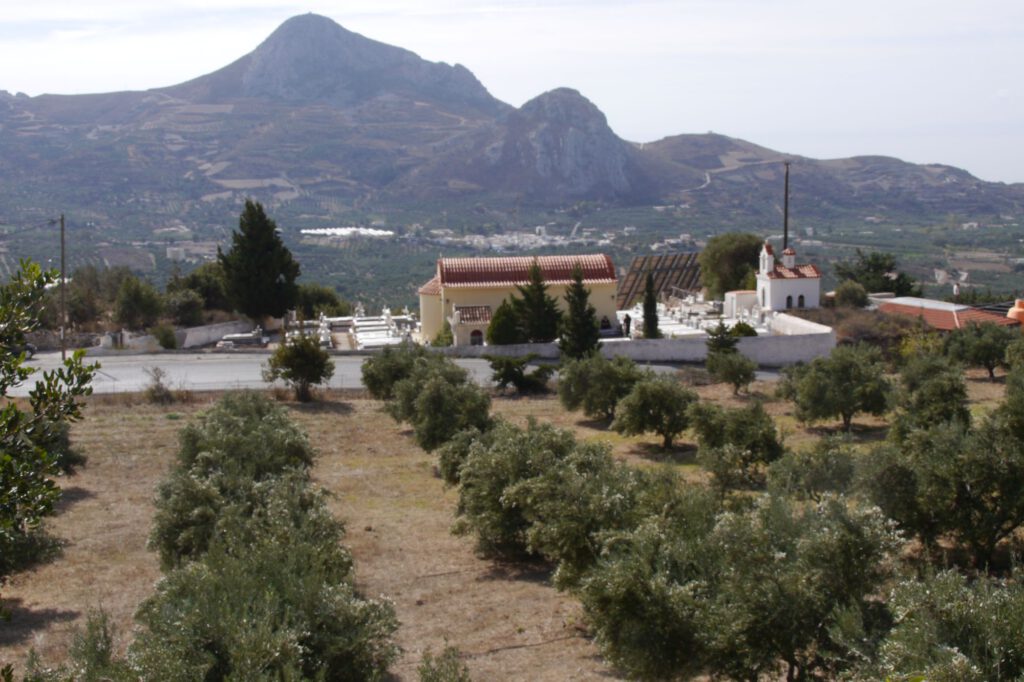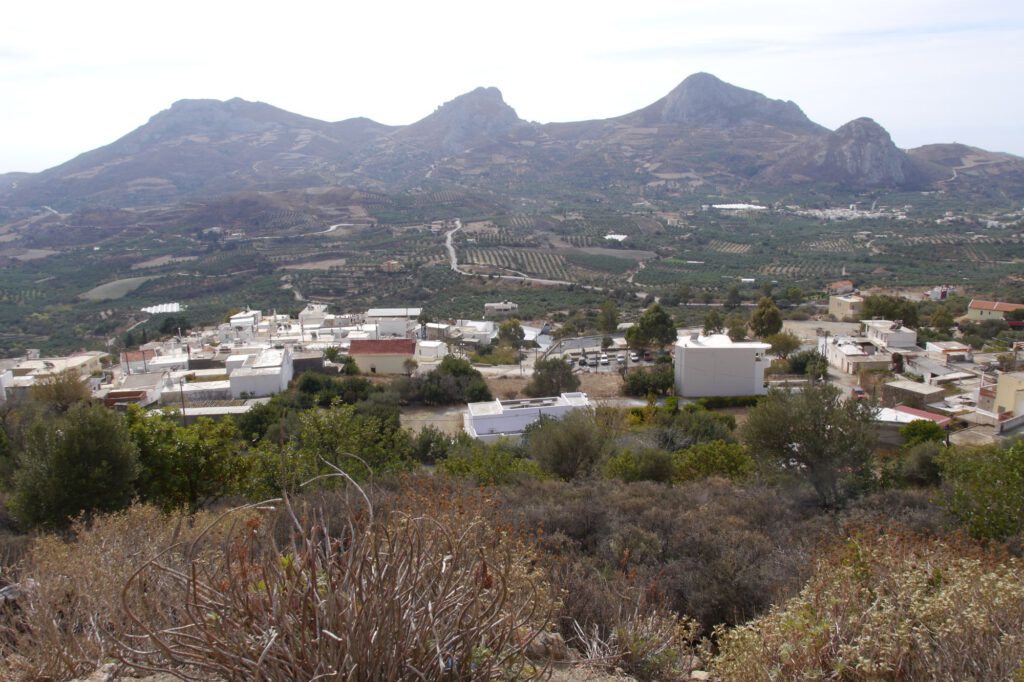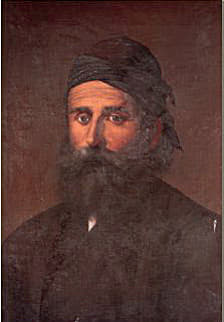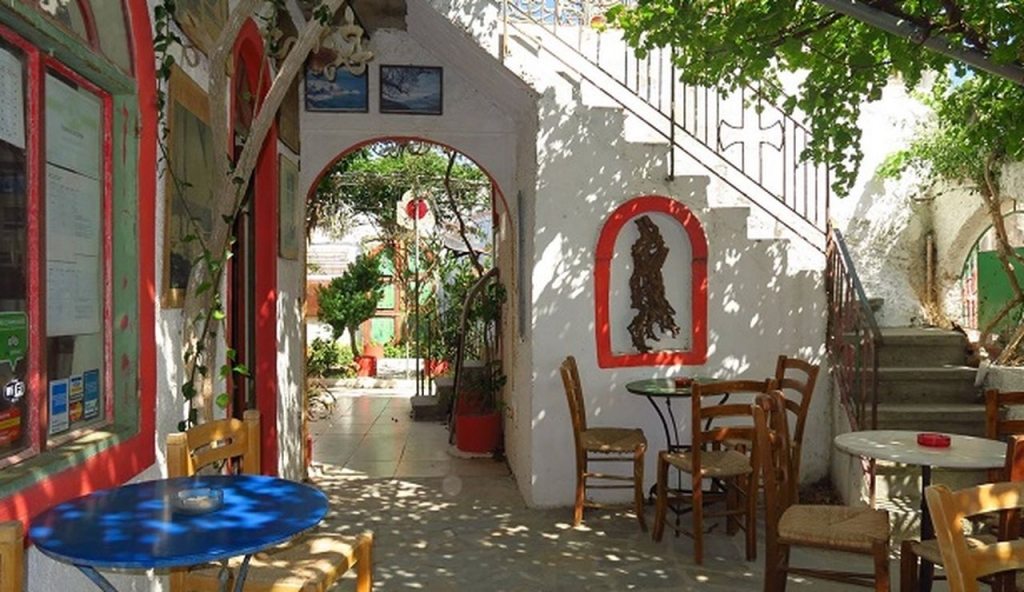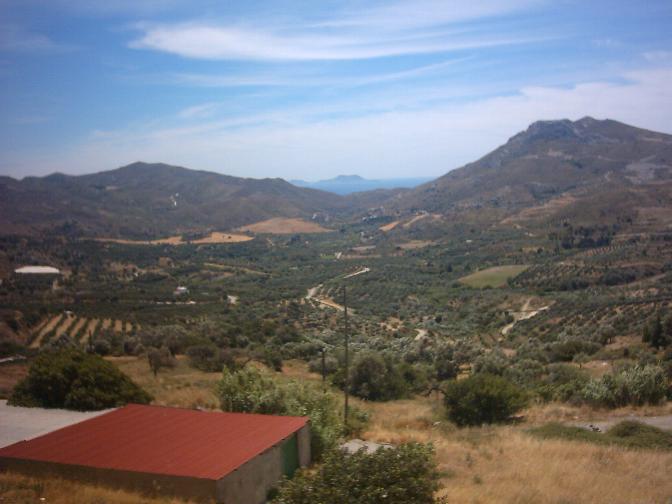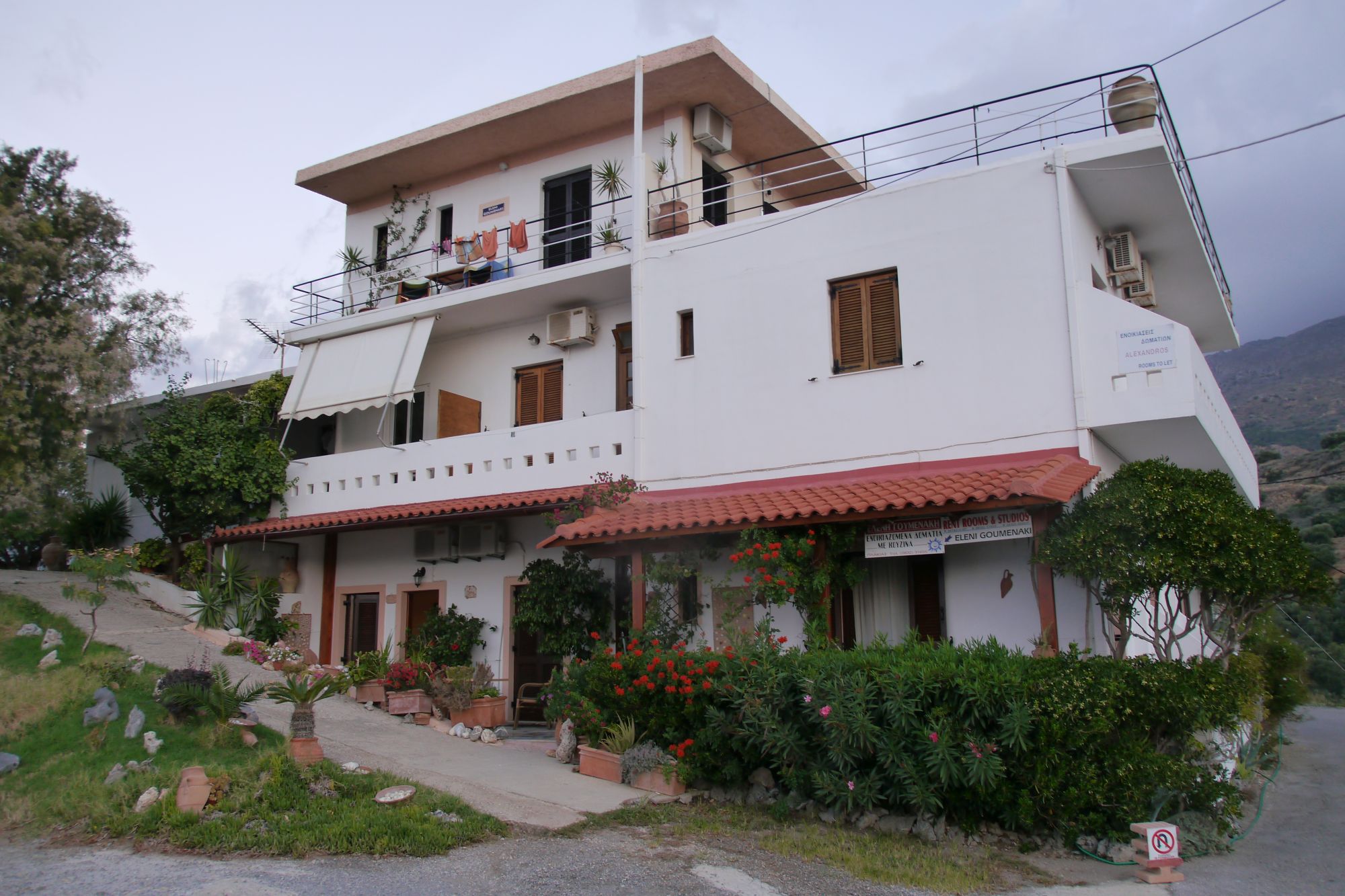The local community of Asomatos comprises the settlements: Asomatos, Kato Moni (Lower Monastery) Preveli and Piso Moni (Rear Monastery) Preveli. It has 232 inhabitants according to the 2011 census (Rear Preveli Monastery 2 monks). It is located west of the exit of the Kourtaliotis gorge towards the Libyan Sea at an altitude of 230 m and is hardly touched by tourism. Usually without stopping, you pass through the village, every time you come from Plakias and want to cross the Kourtaliotis gorge or vice versa.
The village is mentioned in 1577 by P. Barozzi as Assomato de Mega Potamo (Kourtaliotis) in the province of Agios Vasilios, in 1583 by Kastrofylakas with 89 inhabitants and in 1630 by Vasilikata as Assomato di Mega Potamo. In the Turkish census of 1659 Assomatos is listed with 30 houses. Later, in the Egyptian census of 1834, the village is mentioned as Asomatos with 15 Christian families, and in 1881 with 143 Christian inhabitants.
In 1940, the name of the village is pronounced in the plural (Asomatoi) with 216 people living there. Other population figures: 1951 with 186 inhabitants, 1961 with 177 inhabitants (of which Lower Preveli Monastery with 13 and Rear Preveli Monastery with 10 monks), 1971 with 179 inhabitants (Lower Preveli Monastery 4 and Rear Preveli Monastery 6 monks); 1981 with 154 inhabitants. (Lower Preveli Monastery 9 and Rear Preveli Monastery 5 monks); 1991 with 165 inhabitants (Lower Preveli Monastery one monk and Rear Preveli Monastery 3 monks); 2001 with 199 inhabitants (Lower Preveli Monastery 2 and Rear Preveli Monastery 6 monks).
Naming
The name of the village comes from the 14th century central church of Archbishop Michael, the Church of the Saints Asomaton Michael and Gabriel (ο ναός των Αγίων Ασωµάτων). The word or term Asomatos means “incorporeal/unbodied” and in this sense refers to the archangels Michael and Gabriel.
Outstanding persons of the village
α) The Tsouderoi
Assomatos is the home of the Tsouderos family, whose members were active during the various Cretan revolutions. It is considered a very important family in Cretan history.
Tradition has it that the Tsouderoi came from a branch of the Kallergis family from Koksare, Agios Vasilios Province. Born Emmanuel Kallergis in 1690, he took the name Tsouderos after being slightly “burnt” by a burning candle on his head as a student in the monastery of Preveli by a completely accidental and unforeseen event (derived from τσούζω – to burn, note of the author).
1) Emmanuel Tsouderos, first Deputy Governor and later Governor of the Bank of Greece (1928-1939) and Greek Prime Minister during the Battle of Crete (1941-44).
2) Georgios Emm. Tsouderos was a marshal in the revolution of 1821. He took part in all the revolutions until 1830 and had the supreme command of the province of Agios Vasileios. King Otto appointed him colonel of the royal phalanx in recognition of his services (1838). He died in 1849 at the age of 91, spiritually broken after the failure of the revolutionary movement of 1841 in Crete.
3) Melchisedek – the pseudonym of Michael Tsouderos (1769 – 1823) – was the head of the Preveli Monastery and an active member of the Society of Friends (Secret organisation founded in preparation for the revolution of 1821, for the liberation of the Greeks from the Ottoman Empire, Note of the author). He was also the leader of a revolutionary body and a pioneer of the Cretan revolution. As head of the monastery of Preveli, he was called “Tsouderogumenos” by all the inhabitants of the province of Agios Vasileios. In 1823 he was mortally wounded in a battle near Kissamos.
4) John Tsouderos, brother of Abbot Melchisedek and George Tsouderos, actively participated in famous battles (Kali Sykia, Spili, Amari, Polemarchi). He alone captured the head of the Turks, Mustafa, and left all his comrades-in-arms speechless. It is significant that the captured Mustafa gave his heavy weapons to John and paid tribute to his courage and bravery. He was also one of the first to participate in the new revolution of 1841.
5) Anagnostis was the son of Marshal Georgios Tsouderos and was a leader in the province of Agios Vasilios. He had military successes in the conflict with the Turks at Monachi Elia and on the hill of Agios Antonios, at the northern entrance to the Preveli Gorge. The aim there was to prevent the Turkish army’s attempt to cross the Kourtaliotis Gorge, apparently to destroy the Preveli Monastery.
6) Another of the Tsouderoi, Ioannis (son of Anagnostis), was not only a fighter and doctor, but also an advisor to the Cretan state (first to the Ministry of the Interior and then to the Ministry of Finance).
7. Last but not least, it should be mentioned that the current olive oil mill (and apparently also the attached building and agricultural supplies business) is run by Vanggelis Tsouderos, stemming from an old family tradition.
b) Nikodemus Soumbasakis
From Asomatos came the art and music lover, active and progressive hierarch of the Metropolis of Lambi and Sfakia, Nikodemus Soumbasakis (1795-1845). As friar of the Preveli Monastery, he studied in Constantinople and was particularly concerned with the education of the clergy of his diocese and the rise of education in the region. So he organised schools that were maintained by the monastery of Preveli. He tried to revive the famous Monastery of the Holy Spirit in Kissos. There he founded the first and only School of the Holy Spirit in the province of Agios Vasilios (which was to serve not only the province of Agios Vasilios, but also the provinces of Cenurion and Pyrgiotissa).
c) The Holy Nikolaus of Kourtaliotis, the springs of Kourtaliotis
According to a collection of legends (by the legionary Titou Silligardakis), Asomatos is also the birthplace of Saint Nicholas of Kourtaliotis, descended from pious and wealthy parents (late 16th century). He is said to have been so God-fearing that even as a child he was granted the grace to work miracles. He then lived ascetically in the Messara for many years until he finally settled in the Kourtaliotis Gorge. Even today, the village retains a strong tradition around him. It is said that the formation of the five cascading springs that form the river Kourtaliotis is attributed to his miraculous deed. Although the saint is not recognised as a saint by an official decision of the Ecumenical Patriarchate, he has been included in the Cretan calendar of saints, and his memory is commemorated on 1 September with a special service and great pomp. The chapel next to the springs is named after him.
d) From Asomatos also come the Macedonian Stelis-Stelioudakis und Styl. Kallonas (1899-1970), brigadier general and writer who took part in the Battle of Crete at Rethymno and led many soldiers, as well during the resistance.
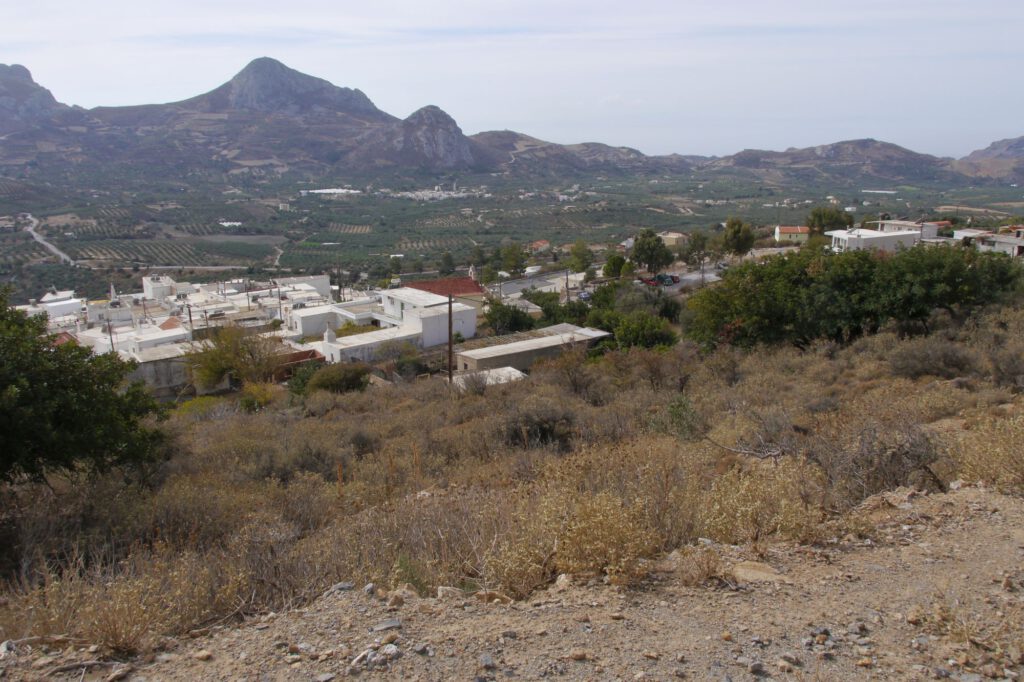
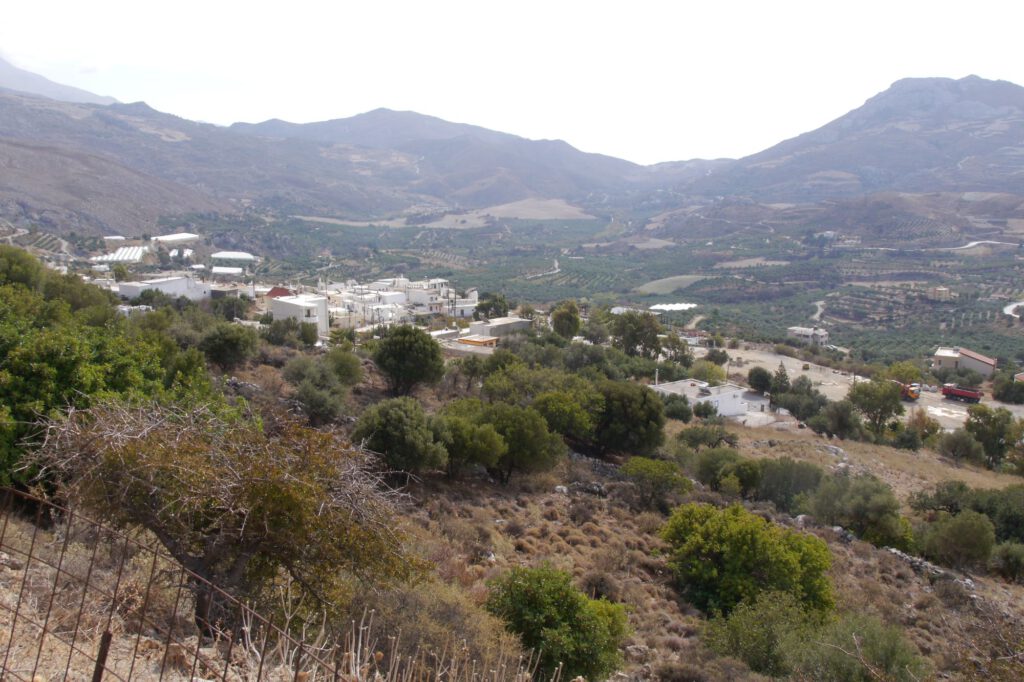
Surroundings
From the village there is a great view of the plain leading to the sea (the Gialia – Γιαλιά) and the extensive olive groves there (likewise towards Preveli), which was the result of a comprehensive programme of land redistribution and irrigation. Thus, the main occupation of the inhabitants is still agriculture.
Added to this is the grandiosity of the Kourtaliotis-Gorge (see here).
Oriseum – a folklore museum
In any case, the private folklore museum of Papa Michalis Georgoulakis (known beyond the region) is worth seeing and visiting. In the museum the visitor can expect a rich collection of objects of everyday life, as well as furniture and tools that reflect the Cretan tradition. Objects from the church, historical treasures from the years of Turkish rule, the two world wars and subsequent political events, as well as numerous documents give an idea of Cretan history. The effort and love that Papas Michalis has put into this 60 year collection is an expression of his love for his Cretan homeland. This museum with its collection is located in his old, traditional house, which is an inseparable part of the collection. Papas Michalis died in 2008. Since then, the museum has been run with great commitment by his son and his German wife.

Churches
- The Byzantine church of the Saints Asomatoi/Άγιοι Ασώµατοι, after which the village was named. It has small dimensions (5.30 x 2.60) and is located a little below the village, near the oil mill.
- Church of St. John (the Baptist)/Αγίος Ιωάννης (του Προδρόµου), east of the village, near the Frati Gorge. Several frescoes are preserved, such as two of the four hierarchs in the niche of the sanctuary, the Holy Mandylion in the pediment – above the niche of the sanctuary – and the Assumption at the eastern end of the arch.On the north wall of the nave are scenes from the life of John the Baptist, in particular his birth. The south wall shows the birth of Christ, the baptismal font and traces of other frescoes.
- Church of St. Nicholas/Άγιος Νικολάος (in the ravine by the springs)
- Church of St. Anne/Αγία Άννα
- Church of Saint Kyriaki/Αγία Κυριακή (a cave church in the Kourtaliotis gorge, next to the road).
- Church of St. John of Prasioni /Άγιος Ιωάννος του Πρασιώνη
- Church of St. George/Άγιος Γεωργίος
- Church of the Transfiguration of the Saviour/Μεταµορφώσεως του Σωτήρα, also near the Frati Gorge.
Schools
It is not known when the first school opened in the village. However, there are records from the 1932-33 school year (with 35 students). In 1968 a school was built at state expense. It operated until the 1996-97 school year.In the following school year, the sixth grade primary school was opened in Plakias, which took in the pupils from the neighboring villages (Asomatos, Gianniou, Mariou, Myrthios, Lefkogia and Sellia).
Economy and culture
The inhabitants are mainly engaged in agriculture and animal husbandry. The village produces a lot of carob, oil, cattle and a few vegetables.
Tourism hardly plays a role.There is a pottery (‘Hydra’ – a branch of the pottery of the same name in Rethimnon), two kafenia and a tavern during the season. There is also an olive oil mill and a business for construction and agricultural needs.
Wealth of caves
The village has a remarkable wealth of caves that it shares with the Preveli Monastery. These caves are numbered in the Speleological Register of Crete (A.Σ.Μ.K. Αριθμό Σπηλαιολογικού Μητρώου Κρήτης). Some of the apparently 19 caves are listed here, unfortunately (almost) without information about the location:
- Cave Skordospilia /Σκορδόσπηλια (AΣMK. 2841). It takes its name from a garlic-like plant that grows in the fertile zone of the cave.
- Cave Kinigospilio /Kοιniγόσpilio) (AΣMK. 2839). Village hunters used to go to this cave when it rained or to rest.
- Roumanis Spiliari /Ρουµάνη το Σπηλιάρι (AΣMK. 201).
- Igumenospilio /Ηγουµενόσπηλιο (A.M.C. 1286). At the rear monastery. Here, around 1810, the leprous abbot of the monastery of Preveli, Makarios, isolated himself at his own request, hence the name of the cave. Patients from the Preveli monastery stayed here during the revolutionary period, or mainly the leprous monks were isolated here in times of peace.
- Foxhole /Αλεπούς την Τρύπα.A deep cave, east of Plakias village, for which the ‘Legend of the Rooster’, known in other villages, has spread. It is said that they took a rooster, put it in this cave and it came out a few kilometers away, in the village of Atsipades. Of course, the presence of a fox on Crete has never been proven, so one should rather think of the well-known Cretan skunks, Zourides or Arkalos, which are found on the island.
- Cave of the Ikons /Σπήλαιο των Εικόνων (A.S.M.K. 1285) in the area of Preveli. It is said to have been used as a hiding place for icons and ecclesiastical objects in the past.
- Cave of Agios Onoufrios/Αγίου Ονουφρίου (AΣΜK 1280), south of the rear monastery of Preveli.
- Cave of Agiothesi (Αγιοθέσι = place of the saint), where according to tradition Agios Nikolaos of Kourtaliotis stayed. In this latter cave, popular devotion even reveals the pits formed by the knees of the praying saint.
The monasteries of Preveli
Lower Monastery Preveli (Kato Moni Preveli – Κάτω Μονή Πρέβελη): the Lower Monastery or Monastery of the Megalos Potamos (Big River – Μεγάλος Ποταμός) ) is now a ruin and dilapidated. There are ruins of buildings that were inhabited by peasants of the monastic land and by overseers of the monastery during the previous centuries. In the same area there were also warehouses for farm products and supplies.
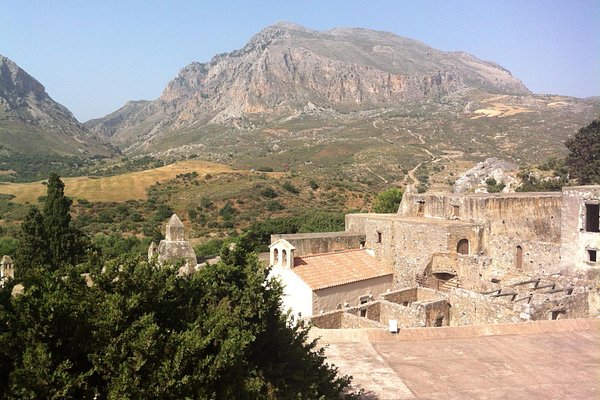
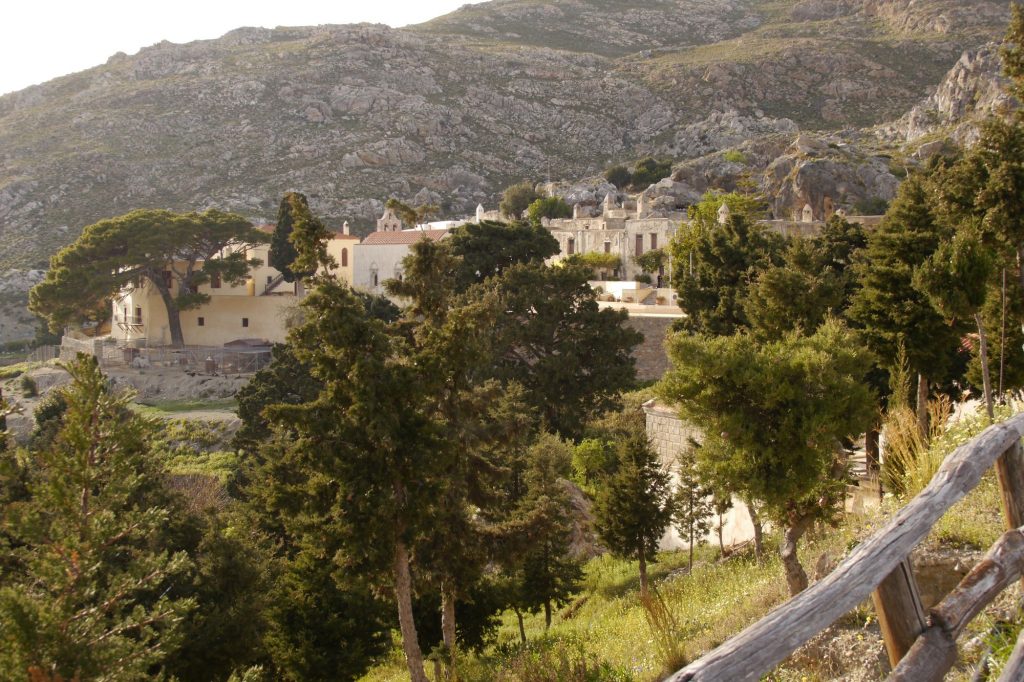
Rear Monastery of Preveli (Piso Moni Preveli – Πίσω Μονή Πρέβελη): The view from the monastery is exotic with a view of Lake Preveli and the mouth of Megalos Potamos. The monastic building complex was founded by a feudal lord named Prevelis, is 37 km from Rethimno and built on successive levels according to the slope of the ground. The stables and warehouses were located on the lower level. The fountain with an inscription has been preserved in the lower courtyard. The church was built in the first half of the 19th century.The ikons, after successful cleaning by the Byzantine Antiquities Restoration Service, are fantastic. One of the treasures of the monastery is the miraculous cross of Preveli, which two attempts were made to steal, but failed. It (the monastery) played an important role in the uprising of 1821, but also during the occupation. It organized the uprising and made itself available as a place of refuge for the persecuted and starving.
A beautiful sight is the stone bridge over Megalos Potamos, about a kilometer north of Preveli Beach.
Sources:
official website of the Municipality of Agios Vasilios
Χώρια της π. Επαρχίας Άγιου Βασιλείου Ρεθύμνου; Τόμος Δ (4) του Έκδοδη Διεθνούς επιστημονικού συνέδριου για την πρώην επαρχεία Άγιου Βασιλείου; Ρέθυμνο 2011, Κώστης Ηλ. Παπαδάκης – Ασώματος – σελ. 183
Villages of Agios Vasilios Rethymnon district; Volume D (4) of the Edition of the International Scientific Conference on the Former Province of Ayios Vasileios; Rethymnon 2011, Kostis Il. Papadakis – Asomatos – p. 183ff.
The 7-volume documentation can be downloaded as a PDF here: https://anemi.lib.uoc.gr/metadata/c/d/8/metadata-1404384170-913351-22914.tkl

























